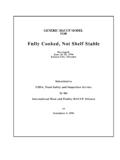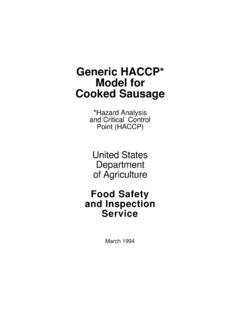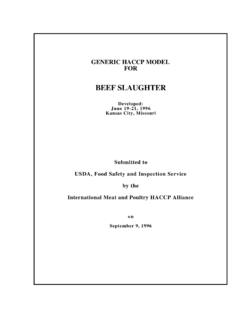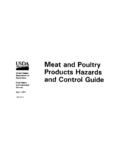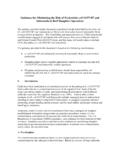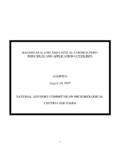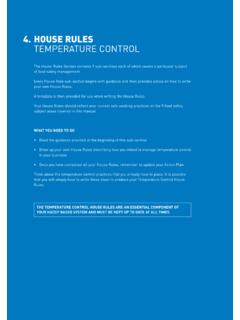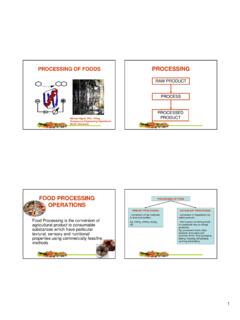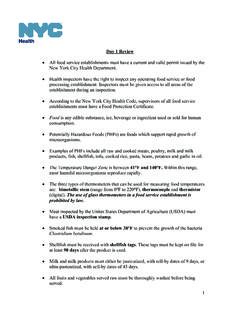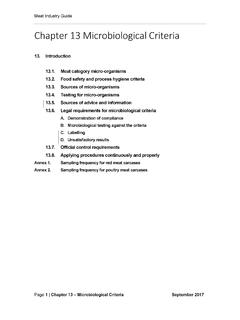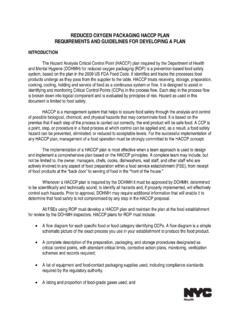Transcription of Guidelines for Developing and (ESTRs ... - HACCP Alliance
1 Guidelines for DevelopingGood Manufacturing Practices (GMPs),Standard Operating Procedures (SOPs)andEnvironmental Sampling/TestingRecommendations (ESTRs )Re ady-to-Eat (RTE)ProductsIn Cooperation WithNorth American Meat Processors; Central States Meat Association; South Eastern Meat Association; Southwest Meat Association;Food Marketing Institute; National Meat Association; andAmerican Association of Meat Processors (pending final approval)April 1999ii This is not a regulatory document. These recommendations were developed by industry represenatives for producers of RTEproducts to use to develop plant-specific GMPs and Guidelines for Developing Good Manufacturing Practices (GMPs)and Standard Operating Procedures (SOPs) for Ready-to-Eat (RTE) Products11. Good Manufacturing Practices (GMPs)..42. Standard Operating Procedures (SOPs).. for Environmental Sampling /Testing Recommendationsfor Plants Producing Ready-to-Eat Recommended Approach to Environmental Microbial Sampling.
2 152. Description of Laboratories Procedures ..19 Appendixiii This is not a regulatory document. These recommendations were developed by industry represenatives for producers of RTEproducts to use to develop plant-specific GMPs and SOPsINTRODUCTIONR eady-to-Eat (RTE) meat products are important, convenient meat food products. They are widelydistributed and consumed as snack foods, sandwich fillings, picnic items, deli buffet foods, and inlots of other ways without any further food preparation. They are a truly convenient food formillions of consumers, and they are presumed to be safe to eat by consumers as strains of Listeria species, a microorganism that exists widely in the environment, havebeen found to be pathogenic to the human population as well as to the animal population. Listeriaspp., unlike most other pathogens, continues to grow, albeit slowly, under refrigerated heat processing of RTE products destroys these bacteria; however, extraordinary handlingpractices after cooking are needed to prevent recontamination.
3 Such handling is particularlyimportant to prevent recontamination with Listeria spp., because they will continue to grow evenwhen the product is vacuum packed and held under refrigerated of pathogenic microorganisms at very low levels on product is always difficult; it s evenmore difficult if they occur sporadically, and the distribution is likely to be sporadic inrecontamination circumstances ( not uniformly distributed). Aggressive preventive strategies arethe best way to assure the safety of RTE products, coupled with an environmental microbiologicalsampling and testing program to identify and eliminate any possible entry opportunities for thisfamily of microorganisms when RTE products are being handled and/or group of organizations sponsored the development of these Guidelines for Good ManufacturingPractices (GMPs), Standard Operating Procedures (SOPs) and Environmental Sampling andTesting Recommendations (ESTRs) for Ready-to-Eat Products.
4 Operational personnel from firmsproducing RTE products met with Dr. Kerri Harris for a working group session to develop theGMPs and SOPs that are set forth herein. In addition, a group of industry microbiologists metwith Dr. John Blackwell to develop the ESTRs that are set forth herein. All persons who providedtheir time and energy in this project are acknowledged : Dr. Kerri Harris, Institute of Food Science & Engineering, Texas A&M University,College Station, TX and Dr. John Blackwell, Food Marketing Services International Inc., Columbia,MDParticipating Organizations: American Association of Meat Processors; North American MeatProcessors; Central States Meat Association; South Eastern Meat Association; Southwest MeatAssociation; Food Marketing Institute; and National Meat AssociationParticipating Microbiologists: Dr. Steve Goodfellow, Deibel Laboratories; Mike Craig, ABCR esearch Corp; Ken Kenyon, Deibel Laboratories; Gina Bellinger, IDEXX Laboratories; Dr.
5 MargaretHardin, National Pork Producers CouncilParticipating Individuals: Bruce Barry, Oberto Sausage Co., Kent, WA; Chris Bodendorfer, EmmpakFoods, Inc.; Troie Burch, Quik-to-Fix, Dallas, TX; Dr. Robert Delmore, Clougherty Packing Co., LosAngeles, CA; Dr. Jill Hollingsworth, Food Marketing Institute; Jason Jennings, Jennings PremiumMeats, New Franklin, PA; Teresa Frey and Rosemary Mucklow, National Meat Association; FredReimers, Grocery, San Antonio, TX; Jonathan W. Rocke, RMH Foods, Morton, IL; Sereke-Jim Tecklu, International Trading Corp, Houston, TX; Tim Wampler, Elm Hill Meats, Lenoir City, This is not a regulatory document. These recommendations were developed by industry represenatives for producers of RTEproducts to use to develop plant-specific GMPs and SOPsIGuidelines for Developing Good Manufacturing Practices (GMPs)and Standard Operating Procedures (SOPs)for Ready-to-Eat (RTE) Productscoordinated by Dr. Kerri Harris, Associate DirectorThe Institute of Food Science and Engineering, College Station, TexasINTRODUCTIONP roducers of ready-to-eat (RTE) products understand the importance of Developing andimplementing procedures to reduce the potential for contamination with microorganisms such asListeria monocytogenes.
6 Therefore, it is extremely important that manufacturers of RTEproducts develop and implement effective Good Manufacturing Practices (GMPs) and StandardOperating Procedures (SOPs) as the foundations of a successful HACCP program. Combiningstrong GMPs, SOPs, SSOPs and HACCP will increase the total process control system and helpthese manufacturers continue to produce the safest products possible. The development andsuccessful implementation of these programs requires full management support and document provides general recommendations for Developing GMPs and SOPs for RTEoperations, and it can be used as a guideline for Developing plant specific GMPs and SOPs. Italso addresses the issues of reprocessing product and recommendations for effectively usingenvironmental testing for Listeria species. These recommendations focus solely on the RTEproducts. It is important to note that the following items are not addressed in detail in thisdocument, but they should be covered by existing Sanitation Standard Operating Procedures(SSOPs) or other plant-specific processing programs: Personnel - disease control, hygiene, clothing, training, etc.
7 Plant and grounds - construction and design, product flow, drainage, etc. Sanitary operations - general maintenance, cleaning and sanitizing, pest control, etc. Sanitary facilities and controls - water supply, plumbing, sewage disposal, rubbish andoffal disposal, etc. Freezers and coolers - monitored and maintained to ensure temperature control, recordingdevices, alarms, etc. Equipment maintenance and calibration - adequate frequency for thermometers, recordingdevices, compressed air equipment, etc. Recall program - It is recommended that all RTE facilities develop a recall program andthat mock recalls should be conducted periodically to ensure that the program works of the items listed above are also addressed in 21 CFR Part 110 - Current GoodManufacturing Practice in Manufacturing, Packing, or Holding Human Food, developed by theFood and Drug Administration and can be used as a resource if more information on any of theseareas is This is not a regulatory document.
8 These recommendations were developed by industry represenatives for producers of RTEproducts to use to develop plant-specific GMPs and SOPsReady-to-Eat (RTE) Products are perishable refrigerated/frozen items such as luncheonmeats, frankfurters, cooked patties and other fully cooked products and meals that do not requirefurther heating before consumption. Therefore, it is important that appropriate heat treatments areapplied and that all possible steps are taken to reduce potential contamination after the heattreatment or post-processing. It should be noted that each processor must validate the cookingprocess for these products and meals as part of the HACCP development and will ensure that the cooking process is adequate to control Listeria. All of these actionswill help manufacturers of RTE products produce the safest products RTE operations should have a lotting mechanism for coding or recording finished products toallow for tracing the product back through the system and for tracing the product forwardthrough the chain.
9 Some establishments may develop computerized bar codes or trackingsystems that are very elaborate and detailed, and others may have simple handwrittendocumentation and box/package codes. Lotting is driven by some time factor ( , hour, shift,day, etc.) and is given a specific code. Creating smaller lots or utilizing a sub-lotting system fortracking information may help demonstrate/document process control and could possibly help tominimize the economic impact of of the mechanism, each operation should have a record keeping system, and it isrecommended that the following items be documented for each identified lot/sub-lot. Raw material source(s) by vendor and including vendor lot identification Data collected during process (temperatures, microbial data, etc.) Equipment evaluation records ( , maintenance records) Other items as specified by individual customerIf any abnormal indicator is found during the process then it is recommended that the product besegregated, that cleaning and sanitizing of the processing line is completed prior to reinitiatingproduction, and that a new lot/sub-lot is started when production starts back up.
10 Someoperations are implementing a sublotting system that requires the following types ofdocumentation: Batching records These records should identify the types of raw material used byits tracking codes; the amount used in each batch of formulated product, the time itwas used and the locations of equipment it was used on. Packaged product tracking systems The finished products should be coded withthe actual times they are packed and sealed and pallets of products should containconsecutive products off the line. Packaging systems with multiple lines should havea consistent flow of raw materials to each packaging line and the ability to code andidentify products from a specific line as necessary. Downtime tracking sheets can beused to identify lines that were not packaging products at the time of suspectincidents and therefore created a break in the flow of products through the system. Finished Product On-Hold Programs If a company is testing finished RTEproducts for potential microbial adulterants, then it should require appropriateproduct/lot(s) to be held until laboratory testing is completed and the results areavailable.
